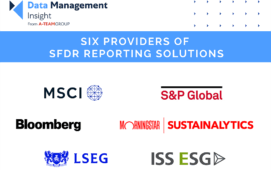
Nine years ago, the United Nations established its 17 Sustainable Development Goals (SDGs) as the baseline guide bringing global environmental and social harmony. It is intended primarily as a framework for nations to instigate change within their borders. The SDGs’ clarity of intention and comprehensive coverage, however, have been seized upon by financial institutions to guide their own sustainability strategies.
In response, data and technology providers are meeting their demand for SDG-focused metrics and benchmarks.
Into this fray has entered S&P Dow Jones Indices, a division of S&P Global, which has produced the first two of what is likely to be an array of SDG-alignment indexes.
The S&P 500 SDG Index and the S&P Global LargeMidCap SDG Index were a year in the making and provide the tools for institutions to create their own financial instruments and also to track the performance of their own ESG investment strategies.Jaspreet Duhra, Global Head of Sustainability Indices at S&P DJI, said investor interest in aligning their strategies with the SDGs has been on the rise for some time.
“The SDGs really seem to have captured the imagination of some investors in terms of measuring their portfolios,” Duhra told ESG Insight from her office in London. “They are the backbone of sustainability.”
‘Clear’, ‘Confusing’
Duhra said the growing taste for SDG-aligned indexes is partly attributable to the “clarity” they bring to a “confusing marketplace” in which a bewildering number of metrics and methodologies compete for investor attention.
The SDGs are “clearly defined,” Duhra said. “ESG scores and these are kinds of metrics are driven by the research houses so there’s arguably a bit more bespoke thinking that goes into those frameworks. When you’re looking at an SDG framework, generally the approach the market is taking is to look at the revenues that companies are getting from different products and how they align with the SDGs.”
With their parent indexes the S&P 500 Index and the S&P Large MidCap Index, the new gauges have been constructed to maximise exposure to revenues that are positively aligned with the SDGs and at least halve those that are negatively aligned.
For instance, while S&P 500 revenue is 28 per cent derived from firms with net SDG-positive revenues, the new gauge are 55 per cent aligned. And the 14 per cent of S&P 500 Index revenue that comes from SDG-negative activities, the new benchmark offers zero such exposure.
Baseline exclusion screens applied to both eliminate exposure to “problematic business activities” such as arms and tobacco suppliers, and the indexes have been optimised to reduce carbon intensity by 30 per cent compared with their parent indexes.
Revenue Categories
Duhra stresses that this is an index-level framework, and not one applied to individual index constituents; companies will be considered SDG-negative if their net revenue is negatively aligned.
“This is in line with what we’re hearing from investors in the market,” she said. “We’ve taken a multi-faceted, holistic approach to sustainability – we’re not just focused on one thing.
S&P DJI built the indexes on ESG data that comes from its parent’s S&P Global Sustainable 1 databases and corporate SDG-alignment data from Impact Cubed, a strategic partner of Euroclear group.
The London-based company takes what it calls a three-dimensional approach to ESG data, which considers risk, return and impact simultaneously. Their technology divides global economic activity into 2,300 revenue categories and then applies those to the 17 SDGs to gauge alignment.
“We wanted to wait for the right database,” said Duhra. “We’ve been exploring the market comparing different data vendors. We’re very happy with the data that we’ve chosen to go into this particular product.”
With Impact Cubed’s data in place, Duhra said that S&P DJI hopes to unveil more SDG-aligned indexes in the near future. She sees ample opportunity in Europe, where sustainability regulation is helping driving demand for new metrics.
“Regulation is something that we spend a long time a lot of time thinking about, it’s something that we’re going to continue to think about as it impacts us and as it impacts our clients,” she said. “But there’s also scope and appetite for innovation outside of regulatory indices.”
Subscribe to our newsletter




